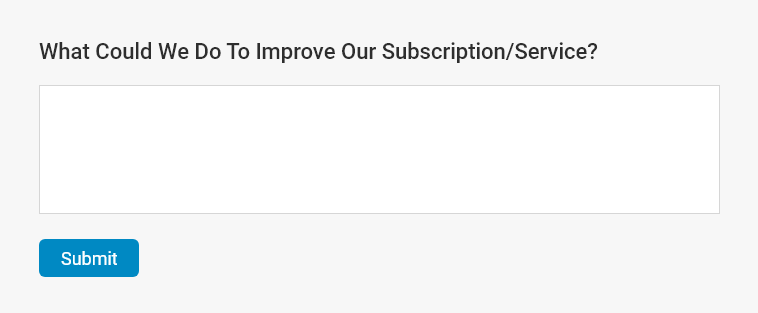
Many businesses interchangeably use the terms questionnaires and survey. But there is a huge difference between surveys and questionnaires. Let’s have a look.
Consider the following scenario:
You want to collect the customers’ demographic information to segment them based on age.
Will you prepare a questionnaire or survey in this scenario?
In this situation, you will need a questionnaire since your purpose is only to collect specific data from individual respondents. You are not looking to examine data to notice any trends or behavior.
A survey, on the other hand, involves collecting feedback and analyzing data.
In this blog, we will explore the answer to the question, “Is a survey the same as a questionnaire?”
We will also discuss which one you should use to achieve your market research goals and tips to write excellent questionnaires and surveys.
Read on.
What Is a Questionnaire?
A questionnaire is a research tool that includes a list of written questions. These questions can be open-ended, closed-ended, or a combination of both. A questionnaire is used to collect both qualitative and quantitative data based on the types of questions.
The questionnaire’s objective is to gather information about individuals for a particular purpose. Its scope is usually limited, and it doesn’t analyze the statistics or look at the bigger picture.
For instance, before joining a gym, you may be asked to fill out a health check-up questionnaire that contains specific questions about your medical history. The objective of this form is to know about an individual’s medical history and nothing else. It is not concerned with further data analysis to identify any trends or behavior in the data.
Types of Questionnaire
The process of designing a questionnaire becomes effortless with the help of questionnaire software. But before preparing your questions, you must understand the difference between different types of questionnaires that depend on your purpose and the kind of data you want to collect.
Let’s have a look at them:
1. Qualitative Questionnaires
This type of questionnaire usually has open-ended questions that allow respondents to share their opinions and feedback in their own words. Qualitative questionnaires are designed to elicit a more in-depth response that aids your qualitative research.
An example of a qualitative question includes:
“How can we improve our services?” This qualitative question helps businesses identify areas where they can improve their services to boost customer satisfaction.



2. Quantitative Questionnaires
It consists of close-ended questions that ask respondents to choose from a given list of response options. It deals with numerical information so that data can be analyzed quickly. Quantitative questionnaires consist of yes/no questions, rating questions, Likert scale questions, multiple-choice questions, etc., that aid in conducting quantitative research.
An example of a quantitative question is:
“For how long have you been using our products and services?”
3. Demographic Questionnaires
Demographic questionnaires consist of close-ended questions to collect demographic information from users like age, sex, religion, income, ethnicity, etc. This type of questionnaire helps brands understand and define their target user personas and companies to know more about their employees.
4. Psychographic Questionnaires
Marketers use the psychographic questionnaire to divide respondents based on psychological criteria like attitude, personality, lifestyle, value, etc. It is about understanding customers’ thoughts and preferences so businesses can mold their products and services according to their requirements.
For example, asking questions like “How often do you visit our online store?” or “Do you prefer online shopping over offline shopping?” help companies understand their customers’ shopping preferences and accordingly segment the audience based on the nature of the study.
5. Pictorial Questionnaires
A pictorial questionnaire uses images more than text to promote users’ interest in answering the questions. It gets more engagement and survey response rate since respondents find it easy to fill out pictorial questionnaires without reading lengthy text.
Companies mainly use this questionnaire to create brand awareness among the respondents.
What Is a Survey?
A survey is a research method used to systematically collect and analyze data to gain insights into the respondents’ opinions, behaviors, experiences, and preferences. It is not only limited to collecting information using a list of questions (questionnaires) but also involves measuring and analyzing the data using statistical means.
A survey is broader in scope when compared to questionnaires and consists of close-ended questions with a few open-ended questions.
For example, suppose you want to gauge customer satisfaction for your newly launched product. You send questionnaires to your customers to collect their opinions, thoughts, and suggestions about the product- its functionality, effectiveness, price, etc. In this case, their individual responses will not be of any benefit. You must combine, organize, measure, and analyze their collective responses to measure the overall customer satisfaction level. This complete process is a survey.
Unlike the questionnaire, the data in the survey isn’t analyzed in isolation.
Types of Survey
To fully understand the difference between a survey and a questionnaire, it is imperative to look at different types of surveys.
Businesses use various surveys to gain insights into customer or employee satisfaction, measure their loyalty, and obtain user feedback, among many other factors.
Primarily, there are 3 types of surveys employed by companies:
1. NPS Surveys
NPS (Net Promoter Score) Survey is a simple metric that measures customer loyalty by gauging the likelihood that they will recommend your brand to others.
Net Promoter Score is determined by asking a single Likert-scale question on a scale of 1-10:
“How likely are you to recommend our products and services to your friends and family?”
The more the NPS score is, the more satisfied customers are with your brand. NPS surveys help companies to distinguish promoters from detractors.
After analyzing the survey results, companies can take steps to convert detractors into promoters by improving their experience.
2. CSAT Surveys
Customer Satisfaction (CSAT) Survey is a voice of the customer tool that helps businesses gauge the overall customer satisfaction level with your brand and its offerings.
The higher the CSAT score, the more loyal and satisfied customers are. By analyzing the data collected from CSAT surveys, companies can identify the bottlenecks and make improvements to serve their customers better.
3. CES Surveys
Customer Effort Score (CES) survey gauges how much effort a customer undertakes to interact with your business. In other words, it measures how easy a customer finds it to buy something from you, interact with your customer service team, or find the information they require.
By reducing the customer effort score, companies can offer a seamless experience that increases the overall customer lifetime value.
When to Use: Surveys vs. Questionnaires
Some studies require conducting a survey, while others need a well-prepared questionnaire. This section will show examples of when to use a survey vs. a questionnaire and why.
When to Use Surveys
A survey is a perfect option for collecting data from a large sample size. It helps to gather in-depth data to understand better your customers’ and employees’ requirements and opinions.
You can deploy surveys at various customer interaction touch points. For instance, you can use surveys right after a customer has made a purchase, interact with your client support team, or complete a product demonstration. It will help you improve the customer experience at each touchpoint.
You can also use monthly, quarterly, or half-yearly surveys to determine overall customer satisfaction levels and evaluate brand awareness.
In the same way, employers can use surveys to gauge employee satisfaction levels and engagement levels or conduct exit interviews.
In a nutshell, you can improve business, products, and services by analyzing the survey data.
When to Use Questionnaires
Though surveys provide more value for researchers than questionnaires, some situations still need to use questionnaires alone over surveys. However, the use of questionnaires is limited when compared to surveys.
It is usually preferred in cases when you want to gather an individual’s information for different purposes like building an email list, segmenting the target audience via demographic questions, accepting donations, and payment processing. It is also used to gather employee information for conducting job interviews.
Mistakes to Avoid When Writing Survey and Questionnaire
The presence of minor errors or issues while writing surveys and questionnaires can affect the complete process of research, resulting in misleading results.
To ensure an effective data collection process, we have compiled a list of 6 mistakes you can avoid while preparing your questionnaires and surveys.
1. Not Asking Specific Questions
Before preparing the questions, be clear in your mind about what you want to achieve by conducting the survey. Prepare the questions that match your research objectives. Try to include only relevant and specific questions that answer what you want to measure.
For example, instead of asking, “What do you think of our customer service team?”
Ask, “On a scale of 1-10, how satisfied are you by interacting with our customer service team”?
Notice how the second question is more specific and directly asks customers to rate the quality of interaction they have with the customer service team.
Also, do not design a long survey and questionnaire. Use only a few easy-to-understand questions, keeping the language simple. It will help to increase the survey response rate.
2. Using Leading Questions
While preparing questions, do not include leading questions as it will lead to biased answers and ultimately inaccurate data collection.
For example, instead of asking, “How will you rate our excellent customer service team?”
Ask: “Please rate our customer service team on a scale of 1-10.”
Do not make assumptions about customers’ needs, requirements, or experiences. Try to include neutral and direct questions that will gather honest and positive responses from your audience.
3. Combining Two Questions
Do not mix two questions into one, as it will confuse audiences.
For example, instead of asking: “How satisfied are you with our product quality and delivery?”
Ask: “How satisfied are you with the product quality?”
“How satisfied are you with the product delivery?”
Two separate questions are simple to understand and make it easy for respondents to answer.
4. Overusing Open-Ended Questions
Although open-ended questions help better understand your customers and employees, asking too many open-ended questions is not a good idea as participants may experience survey fatigue.
Also, they are time-consuming, and people are unwilling to answer questions requiring in-depth responses. As a result, it may cause a low survey response rate which can stop you from achieving the correct data for your research.
For example, instead of asking an open-ended question, “Tell me about your relationship with your manager.”
Try to ask the same thing by framing a close-ended question, like, “Do you share a cordial relationship with your manager?”
A mix of open-ended and closed-ended questions is a good idea in an ideal situation.
5. Writing Non-Mobile-Friendly Questions
Customers use different types of devices to answer your questions.
For this reason, it’s advisable to draft questions and use that survey maker tool that’s responsive for both desktop and mobile. For example, look at the image below to understand how the ProProfs Survey Maker tool’s survey questions are responsive on desktops and smartphones.
Most survey and questionnaire apps today work well on mobile. But still, make sure to preview your questions on the mobile device first to check if it will look suitable for all users.
6. Using Unclear Jargons or Acronyms
Avoid using complicated words and jargon to convey your survey or questionnaire intent to the audience. Using technical words and acronyms may confuse your audience as they may not be well-versed with these terms. Do not frame your questions in such a way that your audience has to open a dictionary to understand them.
You can use jargon if your audience belongs to the same field or occupation; otherwise, try to refrain from using them.
Instead of asking, “How often do you check your employees’ KPI?
Ask, “How do you measure your employees’ performance“?
Try to speak in the language that connects with your respondents.
Difference Between Surveys and Questionnaires
Let’s discuss the difference between the survey and questionnaire in this section.
A questionnaire is just a list of questions that may or may not be a part of the survey.
On the other hand, a survey is a complete process of creating a questionnaire, distributing it, gathering the data, and analyzing the results.
A survey always involves a questionnaire, but vice versa is not always true. You cannot conduct an efficient survey without preparing a questionnaire.
Also, a questionnaire on its own cannot give you all the answers needed for your research. This is because it collects raw data at an individual level rather than a group.
You need a full-scale survey when you’re trying to identify trends or understand the opinions and decision-driving factors. Raw data can be turned into actionable insights only after analyzing and identifying statistical data over large sample size.
Here is a comparison table of survey versus questionnaire to clarify things further.
| Parameters | Surveys | Questionnaires |
| Basis | Process of conducting research on a particular subject | Data collection method |
| Individual Questions | Yes | Yes |
| Types of Questions | Close-Ended/Open-ended Questions | Close-Ended/Open-ended Questions |
| Number of Questions | Multiple questions | Multiple questions |
| Depth of Questions | Multiple subjects | Multiple subjects |
| Analysis of Responses | Yes | No |
| Time Spent | Time-consuming process | Do not require much time |
| Use | Designed for target audience | Designed for respondents |
| Deployment | Shared via social media, websites, emails, mobile apps, and prototypes | Shared via offline means or email, links, and SMS. |
Conduct Amazing Surveys and Questionnaires Today
Both questionnaires and surveys are vital tools to obtain insights into customer satisfaction. It helps businesses adjust their customer experience strategies to boost customer retention rates.
This makes it vital for every marketer to know the difference between surveys vs. questionnaires and where to use them.
While a questionnaire can work great for capturing individual inputs, surveys can allow you to dive deep into the opinions of larger groups, such as your customers or employees.
Whether you want to design a questionnaire or create a survey, using a robust tool like ProProfs Survey Maker can make the complete process of collecting and analyzing the data a breeze. The tool offers 100+ questionnaire and survey templates and more than 100,000 ready-to-use questions.




Many businesses interchangeably use the terms questionnaires and survey. But there is a huge difference between surveys and questionnaires. Let’s have a look.
Consider the following scenario:
You want to collect the customers’ demographic information to segment them based on age.
Will you prepare a questionnaire or survey in this scenario?
In this situation, you will need a questionnaire since your purpose is only to collect specific data from individual respondents. You are not looking to examine data to notice any trends or behavior.
A survey, on the other hand, involves collecting feedback and analyzing data.
In this blog, we will explore the answer to the question, “Is a survey the same as a questionnaire?”
We will also discuss which one you should use to achieve your market research goals and tips to write excellent questionnaires and surveys.
Read on.
What Is a Questionnaire?
A questionnaire is a research tool that includes a list of written questions. These questions can be open-ended, closed-ended, or a combination of both. A questionnaire is used to collect both qualitative and quantitative data based on the types of questions.
The questionnaire’s objective is to gather information about individuals for a particular purpose. Its scope is usually limited, and it doesn’t analyze the statistics or look at the bigger picture.
For instance, before joining a gym, you may be asked to fill out a health check-up questionnaire that contains specific questions about your medical history. The objective of this form is to know about an individual’s medical history and nothing else. It is not concerned with further data analysis to identify any trends or behavior in the data.
Types of Questionnaire
The process of designing a questionnaire becomes effortless with the help of questionnaire software. But before preparing your questions, you must understand the difference between different types of questionnaires that depend on your purpose and the kind of data you want to collect.
Let’s have a look at them:
1. Qualitative Questionnaires
This type of questionnaire usually has open-ended questions that allow respondents to share their opinions and feedback in their own words. Qualitative questionnaires are designed to elicit a more in-depth response that aids your qualitative research.
An example of a qualitative question includes:
“How can we improve our services?” This qualitative question helps businesses identify areas where they can improve their services to boost customer satisfaction.



2. Quantitative Questionnaires
It consists of close-ended questions that ask respondents to choose from a given list of response options. It deals with numerical information so that data can be analyzed quickly. Quantitative questionnaires consist of yes/no questions, rating questions, Likert scale questions, multiple-choice questions, etc., that aid in conducting quantitative research.
An example of a quantitative question is:
“For how long have you been using our products and services?”
3. Demographic Questionnaires
Demographic questionnaires consist of close-ended questions to collect demographic information from users like age, sex, religion, income, ethnicity, etc. This type of questionnaire helps brands understand and define their target user personas and companies to know more about their employees.
4. Psychographic Questionnaires
Marketers use the psychographic questionnaire to divide respondents based on psychological criteria like attitude, personality, lifestyle, value, etc. It is about understanding customers’ thoughts and preferences so businesses can mold their products and services according to their requirements.
For example, asking questions like “How often do you visit our online store?” or “Do you prefer online shopping over offline shopping?” help companies understand their customers’ shopping preferences and accordingly segment the audience based on the nature of the study.
5. Pictorial Questionnaires
A pictorial questionnaire uses images more than text to promote users’ interest in answering the questions. It gets more engagement and survey response rate since respondents find it easy to fill out pictorial questionnaires without reading lengthy text.
Companies mainly use this questionnaire to create brand awareness among the respondents.
What Is a Survey?
A survey is a research method used to systematically collect and analyze data to gain insights into the respondents’ opinions, behaviors, experiences, and preferences. It is not only limited to collecting information using a list of questions (questionnaires) but also involves measuring and analyzing the data using statistical means.
A survey is broader in scope when compared to questionnaires and consists of close-ended questions with a few open-ended questions.
For example, suppose you want to gauge customer satisfaction for your newly launched product. You send questionnaires to your customers to collect their opinions, thoughts, and suggestions about the product- its functionality, effectiveness, price, etc. In this case, their individual responses will not be of any benefit. You must combine, organize, measure, and analyze their collective responses to measure the overall customer satisfaction level. This complete process is a survey.
Unlike the questionnaire, the data in the survey isn’t analyzed in isolation.
Types of Survey
To fully understand the difference between a survey and a questionnaire, it is imperative to look at different types of surveys.
Businesses use various surveys to gain insights into customer or employee satisfaction, measure their loyalty, and obtain user feedback, among many other factors.
Primarily, there are 3 types of surveys employed by companies:
1. NPS Surveys
NPS (Net Promoter Score) Survey is a simple metric that measures customer loyalty by gauging the likelihood that they will recommend your brand to others.
Net Promoter Score is determined by asking a single Likert-scale question on a scale of 1-10:
“How likely are you to recommend our products and services to your friends and family?”
The more the NPS score is, the more satisfied customers are with your brand. NPS surveys help companies to distinguish promoters from detractors.
After analyzing the survey results, companies can take steps to convert detractors into promoters by improving their experience.
2. CSAT Surveys
Customer Satisfaction (CSAT) Survey is a voice of the customer tool that helps businesses gauge the overall customer satisfaction level with your brand and its offerings.
The higher the CSAT score, the more loyal and satisfied customers are. By analyzing the data collected from CSAT surveys, companies can identify the bottlenecks and make improvements to serve their customers better.
3. CES Surveys
Customer Effort Score (CES) survey gauges how much effort a customer undertakes to interact with your business. In other words, it measures how easy a customer finds it to buy something from you, interact with your customer service team, or find the information they require.
By reducing the customer effort score, companies can offer a seamless experience that increases the overall customer lifetime value.
When to Use: Surveys vs. Questionnaires
Some studies require conducting a survey, while others need a well-prepared questionnaire. This section will show examples of when to use a survey vs. a questionnaire and why.
When to Use Surveys
A survey is a perfect option for collecting data from a large sample size. It helps to gather in-depth data to understand better your customers’ and employees’ requirements and opinions.
You can deploy surveys at various customer interaction touch points. For instance, you can use surveys right after a customer has made a purchase, interact with your client support team, or complete a product demonstration. It will help you improve the customer experience at each touchpoint.
You can also use monthly, quarterly, or half-yearly surveys to determine overall customer satisfaction levels and evaluate brand awareness.
In the same way, employers can use surveys to gauge employee satisfaction levels and engagement levels or conduct exit interviews.
In a nutshell, you can improve business, products, and services by analyzing the survey data.
When to Use Questionnaires
Though surveys provide more value for researchers than questionnaires, some situations still need to use questionnaires alone over surveys. However, the use of questionnaires is limited when compared to surveys.
It is usually preferred in cases when you want to gather an individual’s information for different purposes like building an email list, segmenting the target audience via demographic questions, accepting donations, and payment processing. It is also used to gather employee information for conducting job interviews.
Mistakes to Avoid When Writing Survey and Questionnaire
The presence of minor errors or issues while writing surveys and questionnaires can affect the complete process of research, resulting in misleading results.
To ensure an effective data collection process, we have compiled a list of 6 mistakes you can avoid while preparing your questionnaires and surveys.
1. Not Asking Specific Questions
Before preparing the questions, be clear in your mind about what you want to achieve by conducting the survey. Prepare the questions that match your research objectives. Try to include only relevant and specific questions that answer what you want to measure.
For example, instead of asking, “What do you think of our customer service team?”
Ask, “On a scale of 1-10, how satisfied are you by interacting with our customer service team”?
Notice how the second question is more specific and directly asks customers to rate the quality of interaction they have with the customer service team.
Also, do not design a long survey and questionnaire. Use only a few easy-to-understand questions, keeping the language simple. It will help to increase the survey response rate.
2. Using Leading Questions
While preparing questions, do not include leading questions as it will lead to biased answers and ultimately inaccurate data collection.
For example, instead of asking, “How will you rate our excellent customer service team?”
Ask: “Please rate our customer service team on a scale of 1-10.”
Do not make assumptions about customers’ needs, requirements, or experiences. Try to include neutral and direct questions that will gather honest and positive responses from your audience.
3. Combining Two Questions
Do not mix two questions into one, as it will confuse audiences.
For example, instead of asking: “How satisfied are you with our product quality and delivery?”
Ask: “How satisfied are you with the product quality?”
“How satisfied are you with the product delivery?”
Two separate questions are simple to understand and make it easy for respondents to answer.
4. Overusing Open-Ended Questions
Although open-ended questions help better understand your customers and employees, asking too many open-ended questions is not a good idea as participants may experience survey fatigue.
Also, they are time-consuming, and people are unwilling to answer questions requiring in-depth responses. As a result, it may cause a low survey response rate which can stop you from achieving the correct data for your research.
For example, instead of asking an open-ended question, “Tell me about your relationship with your manager.”
Try to ask the same thing by framing a close-ended question, like, “Do you share a cordial relationship with your manager?”
A mix of open-ended and closed-ended questions is a good idea in an ideal situation.
5. Writing Non-Mobile-Friendly Questions
Customers use different types of devices to answer your questions.
For this reason, it’s advisable to draft questions and use that survey maker tool that’s responsive for both desktop and mobile. For example, look at the image below to understand how the ProProfs Survey Maker tool’s survey questions are responsive on desktops and smartphones.
Most survey and questionnaire apps today work well on mobile. But still, make sure to preview your questions on the mobile device first to check if it will look suitable for all users.
6. Using Unclear Jargons or Acronyms
Avoid using complicated words and jargon to convey your survey or questionnaire intent to the audience. Using technical words and acronyms may confuse your audience as they may not be well-versed with these terms. Do not frame your questions in such a way that your audience has to open a dictionary to understand them.
You can use jargon if your audience belongs to the same field or occupation; otherwise, try to refrain from using them.
Instead of asking, “How often do you check your employees’ KPI?
Ask, “How do you measure your employees’ performance“?
Try to speak in the language that connects with your respondents.
Difference Between Surveys and Questionnaires
Let’s discuss the difference between the survey and questionnaire in this section.
A questionnaire is just a list of questions that may or may not be a part of the survey.
On the other hand, a survey is a complete process of creating a questionnaire, distributing it, gathering the data, and analyzing the results.
A survey always involves a questionnaire, but vice versa is not always true. You cannot conduct an efficient survey without preparing a questionnaire.
Also, a questionnaire on its own cannot give you all the answers needed for your research. This is because it collects raw data at an individual level rather than a group.
You need a full-scale survey when you’re trying to identify trends or understand the opinions and decision-driving factors. Raw data can be turned into actionable insights only after analyzing and identifying statistical data over large sample size.
Here is a comparison table of survey versus questionnaire to clarify things further.
| Parameters | Surveys | Questionnaires |
| Basis | Process of conducting research on a particular subject | Data collection method |
| Individual Questions | Yes | Yes |
| Types of Questions | Close-Ended/Open-ended Questions | Close-Ended/Open-ended Questions |
| Number of Questions | Multiple questions | Multiple questions |
| Depth of Questions | Multiple subjects | Multiple subjects |
| Analysis of Responses | Yes | No |
| Time Spent | Time-consuming process | Do not require much time |
| Use | Designed for target audience | Designed for respondents |
| Deployment | Shared via social media, websites, emails, mobile apps, and prototypes | Shared via offline means or email, links, and SMS. |
Conduct Amazing Surveys and Questionnaires Today
Both questionnaires and surveys are vital tools to obtain insights into customer satisfaction. It helps businesses adjust their customer experience strategies to boost customer retention rates.
This makes it vital for every marketer to know the difference between surveys vs. questionnaires and where to use them.
While a questionnaire can work great for capturing individual inputs, surveys can allow you to dive deep into the opinions of larger groups, such as your customers or employees.
Whether you want to design a questionnaire or create a survey, using a robust tool like ProProfs Survey Maker can make the complete process of collecting and analyzing the data a breeze. The tool offers 100+ questionnaire and survey templates and more than 100,000 ready-to-use questions.
FREE. All Features. FOREVER!
Try our Forever FREE account with all premium features!







